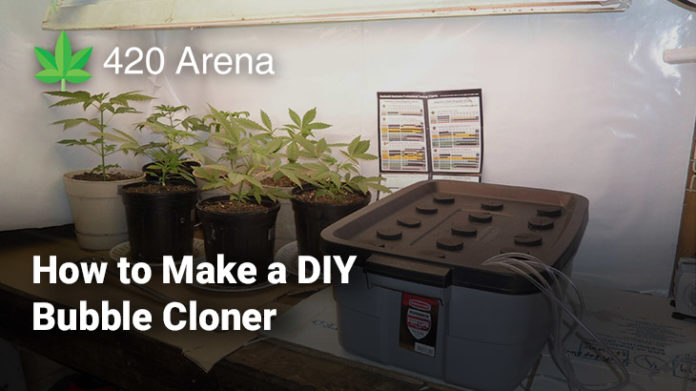When it comes to the world of growing marijuana, DIY products are often appreciated. This is because sometimes the cost of growing weed tends to be so high that the end result, i.e. the weed that you are growing, is available for cheaper out there in the dispensaries. This makes the whole process redundant. Growing your own weed is often costly if you are doing it in a small scale but using professional equipment – at least for the first few batches, after which it starts breaking even – but then the cost of maintenance and replacement also rises. Hence DIY equipment is quite important. Here, we talk about how to make a DIY bubble cloner!
DIY equipment are extensively used when it comes to growing weed as they help bring down the cost of growing weed. Hydroponic growth can often be even more expensive than regular old-school growing. Hence, when it comes to bringing down the cost of growing hydroponic weed, equipment such as DIY bubblers are really well-appreciated. By the time you reach the end of this article, we hope that you will be able to make one of your own with great ease!
However, before we reach the part where we are going to talk about how to make bubble cloners, let us first talk about what these things are and what is their use in the process of growing weed. Besides that, one first needs to understand what cloning is. So let us cut straight into it and discuss in detail the concept of cloning, what bubble cloning is – and then how to make a bubble cloner.
What is Cloning?
When it comes to growing weed, cloning is a process that can help you grow your plants at a much rapid rate. However, cloning is also a process that can take you quite some time master. It is something that pro-growers love to do as it is a challenge that they can take up and it is usually something that beginners and novice growers tend to avoid. No matter what stage of experience level you are in, it is always great to understand the concept first.
The great thing about most plants is that you can actually cut off a shoot and plant it and begin to grow a variant of that same plant in another place. Hydroponic cloning allows you to grow multiple marijuana plants at the same time. This is especially beneficial for growers who are growing weed because sometimes you reach a particular variant of weed which you really like – and you want to grow the same plant again. To maintain the exact genetics you’d rather use cloning than any other process! One plant can possibly give rise to thousands of clones over the years.
There are a number of ways in which cloning can be done. This includes the likes of Rockwool cloning, which is among the most popular. Then there’s Peat Plug cloning which is another method that many people make use of. Lastly, we come to Bubble Cloning, which is what is going to be the highlight of this article – and we shall also be looking at how to make a DIY bubble cloner.
What is Bubble Cloning?
Bubble cloning, simply speaking, is a type of aeroponic cloning method where you will be able to clone your marijuana plants with ease. Here, you basically make use of a lightproof container where a nutrient solution will be used to ensure that the roots of your plants are kept moist at all times. Eventually, you will notice that roots begin to emerge which are small and white at first. This is when you know that your work is showing results!
Compared to medium-based cloning methods such as the aforementioned Rockwool cloning or peat plug cloning, you can actually get better and faster returns here when it comes to growing your plants. Many growers have claimed that their DIY bubble cloners have given them plants which are ready to be transplanted in about 8 days to 12 days, which is quite impressive! Bubble cloners are quite basic and easy to use too.
This process of cloning is the most beginner-friendly (at least as far as cloning goes). There are a number of aeroponic cloners and cloning machines that you can buy off Amazon as well as a number of other websites which sell gardening products. However, let us focus on making our own DIY bubble cloner now. Let us take a detailed look at how to do this up next:
How to Make a DIY Bubble Cloner?
Let us now address the actual reason as to why you are here! Most of our readers are here because they want to learn how to build a bubble cloner at home so that they can get started with the cloning process. Here’s how to make a DIY bubble cloner:
First off, you will need the following things:
- 2 air stones (preferably about 4 inches in size)
- Neoprene discs (2 inches in size)
- Circular drill bits (2 inches in size)
- A black plastic storage bin which has a lid (preferably made of Tupperware)
- A see-through plastic bin with lid (which has to be larger than the black one)
- Air hose
- Adapters for air hose (can be Y adapters or T adapters)
- A very effective ‘hot glue’
Start by taking the dark/black plastic bin’s lid and cut about six holes on it. If the size doesn’t permit six, go for four. Make sure they all have enough space around them. The neoprene discs that you have should fit well on them. Next, take the air stones and stick them to the bottom of the bin. This is done so that they remain in place even if you move your bubbler around. Post that, drill a hole on the side of the bin so that the air hose can reach your air stones.
Fill some water in this setup and check that there are no leaks. Do a test run by turning on the air hose to see how much the water sprays and bubbles and that there’s no overthrow. People are often confused about the kind of water that they need to add to their bubblers but we’d suggest going with regular water with some hydro guard added to it – that’d suit your clones the best in this DIY bubble cloner that you are building. Hydroguard protects your roots from bacterial infections. Your bubbler is now good to go.
Next, we look at creating the humidity dome around it by using the slightly bigger see-through bin. You need to cut a small gap on the rim of this bin so that the air hose is able to enter it well and there won’t be any pinching of the hose that might cause obstruction to the airflow. Put this dome upside down on top of the bubbler. Keep the lid on the bottom and position the bubbler on the center of the lid and shut the dome.
Lastly, some people also like to put a temperature or a humidity monitor to their dome so that they know the exact statistics of the kind of environment that their plants are growing in, but even without that you are good to go. Your DIY bubble cloner is now ready and you can begin growing your clones in it. You would usually get a high humidity here as there’s only one place for the humidity to leak out of, and that too is filled with the hose. People usually get above 85% humidity in their bubble cloners if this is done right.
Your DIY bubble cloner is now ready and has been crafted by your own hands! You can grow your marijuana clones here and have their roots ready in about 8 to 10 days! Do let us know how it goes for you.
Pros and Cons of Using Bubble Cloners
Now that you know how to make a DIY bubble cloner using some objects that can be easily found at your home, let us take a look at the pros and cons of using bubble cloners (especially DIY ones)
Pros
- DIY bubble cloners can be very cheap when compared to getting a bubble cloning machine
- These cloners provide quite a fast result when you compare it with other cloning methods. Here, your plants are ready in about 10 days on an average
- They are very simple to use and can almost be considered a ‘plug and play’ device
- You need to provide minimal supervision while growing your plants using this method of cloning
Cons
- DIY cloners are usually quite small in size and can support only a few plants compared to bubble cloner machines
- You need to clean them frequently. There might be quite a bit of spillage and growers need to be alert about that.
Alternatives to DIY Bubble Cloning
Bubble cloning is basically the process of growing clones without a medium. However, there are a large number of alternatives also available for people who want to grow their clone plants using a medium. Rockwool cloning and Peat Plug cloning are two such ways. We take a look at both of them, as well as aeroponic cloning machines – which are essentially bubble cloners which are not DIY and can be purchased off Amazon or other gardening stores. Here’s a look at the three major alternatives to DIY bubble cloning:
1. Using Aeroponic Cloning Machines
If you insist on going the non-medium way, this is one of the best options that you have. Aeroponic cloning machines cost anywhere between $60 to $200 and can easily be purchased off Amazon. These machines are generally more durable and reliable when compared to DIY bubble cloners which are home-made. These machines also allow you to grow a much larger number of plants (but are also more expensive than what you’d expect a DIY machine to cost).
However, this is truly the more convenient and easy way out which we would strongly recommend to a grower who is planning to be into cloning/growing cloned marijuana for a long time. If you want to experiment or are a one-off grower, we’d suggest you go the DIY way, but for anyone who plans on going long-term with this, an aeroponic cloning machine is what will be best suited for you.
2. Rockwool Cloning
Up next on our list of DIY bubble cloner alternatives is the rockwool cloning method. You might also hear of it as the stone wool cloning method. Rock wool is created when glass is heated at extremely high temperatures and is then separated into fine filaments and then given the form of a cube. These cubes generally have enough space which allow the roots to grow and for the water to move around. This is a porous substance that stores all the essential water and nutrients while also ensuring that the plant gets all the essentials at all times and remains well hydrated.
You’d need a simple cloning gel and a basic cloning solution while growing your plants using this method of cloning. One of the best things here is that you don’t need an electrical pump which is pumping water/air to your plants at all times because the rock wool is such a material which can hold quite a bit of water while allowing your roots to breathe.
3. Peat Plug Cloning
Peat is essentially the name given to the organic mud like material that is obtained from a mix of marshes, swamps, and bogs. It is composed of remains of many different plants and mosses, specifically the Sphagnum moss – which is something that you’d find in most peat cubes. It is a very old and traditional method of growing weed and has been in practice for centuries.
It is quite easy for practically anyone to start growing their cloned plants in a peat-plug setup. It is almost always sold to people pre-moistened and all you need to do is to put your clone in it to get started. However, you might want to keep your eyes open for one small problem – there can be a salt buildup. Bubble cloning, even when done using a DIY bubble cloner, never really faces such a problem and is also easy to use.
Things to Consider While Cloning Your Plants
By this point in the article, you know how to make a DIY bubble cloner, as well as what are the pros and cons of making one. You also know which are some of the best alternative methods available for cloning. However, here are some additional ‘pro’ tips which will help you get the most out of your cloning process and ensure that your plants are healthy and strong.
- First off, remember that hygiene matters a lot! You need to keep everything as clean as possible, especially when you are in the early process and cutting your clones from the parent plant. Make sure you are using a pair of scissors that have been sanitized really well. Also make sure to sanitize your gloves while doing so. After every cut you make, ensure that your scissors or shears are being cleaned with alcohol.
- When making a cut, try and keep it at a 45-degree angle, which is the most well-suited angle for growing clones. Once the clone has been cut from the parent plant, immediately dip it in a jar of clean water. Give each clone a different jar.
- Consider getting a good quality rooting gel for the cloning process. Something like IBA could be highly beneficial for your clones. Clones which are dipped in rooting gel are generally assumed to grow at a much faster pace than compared to how they would grow without it. These gels are also great for the overall root health of the clones. It is not necessary, but using it will enhance your overall experience of growing the roots.
- Keeping your water temperature between 60 to 70F is best suited for cloning. There’s nothing that clones hate more than cold water – and you must keep that in mind! Colder water is not suitable for their growth as well as slows down the overall process of root growth.
- Lastly, plants usually appear fresh while you are cloning them using a bubble cloning method. However, in some cases you might see them turning yellow or pale. Even in those cases you need not worry too much, as the roots are what matter the most. The roots need to remain healthy!
These are some pro tips that we have collated from our experience of growing clones over the years and we hope that this is something that is going to benefit you a lot when you grow your clones too! Remember, using a bubbler – be it a DIY model or be it a machine you purchased, these tips will be applicable to both of them! Cloning as a process remains the same even though how you clone your plants might be different.
Frequently Asked Questions (FAQs) about Cloning
Cloning can be quite a complex process and sometimes it can get overwhelming for growers. Hence, here’s a collection of some answers to these frequently asked questions which will give you a better perspective towards understanding bubble cloners. If there are any more questions, send us a mail or drop a comment and we shall answer it as well and add it here!
1. How long does it take to clone plants in a bubble cloner?
In the case of a DIY bubble cloner, your plants will be cloned in about 8 to 10 days on an average. It might take a few days more or less as well, but this is the standard time. Your plants also remain quite fresh throughout the process. This is the fastest that you can clone your plants.
2. How much does a bubble cloning machine cost?
Depending on how big it is and how many plants you can clone on it, a bubble cloning (aeroponic cloning) machine can cost you anywhere between $60 to $200 on Amazon on an average. However, some products might go below or beyond this range too.
3. Which is the easiest cloning method for beginners?
Bubble cloning is the easiest method for beginners when compared to the likes of rock wool cloning and peat plug cloning. This is also the fastest and the most practical. While it can take some time to set it up, but once you get it started you’ve barely got to do anything! The plants grow by themselves!
4. How many plants can I clone in a bubble cloner at a time?
It honestly depends upon the size of your bubble cloner, but most standard DIY cloners can grow between 6 to 10 plants at the most. Don’t worry too much about the number of plants if you are growing it on a DIY cloner. There are larger 24/32 variants available if you wish to buy a bubble cloning machine.
5. Are bubble cloners noisy?
No, bubble cloners aren’t really ‘noisy’. Since there’s an air pump involved there will obviously be some sound but that’s not too loud and if you are using it in a closed room, it is highly unlikely that the sound will be heard outside your room. It is quite a silent process and noise is one thing you really don’t have to worry about!
Conclusion
We hope that by this point in the article you know everything that there is to know about the process of bubble cloning, including the most important question – how to make a DIY bubble cloner. If you got inspired after reading this article and are planning on building your own bubble cloner, feel free to send us a mail or leave a comment below showcasing the cloner that you have made and we might just feature that here! Furthermore, if you are still having any doubts or queries regarding making your own DIY bubble cloner, please let us know over mail and we shall get back to you as soon as we can! Till then…
…Happy cloning! 🙂
Table of Contents

















![How to Use Carbon Filters in Your Grow Room [7 Best Carbon Filters for Grow Rooms in 2021] How to Use Carbon Filters in Your Grow Room](https://420arena.com/wp-content/uploads/2020/12/How-to-Use-Carbon-Filters-in-Your-Grow-Room-218x150.jpg)













